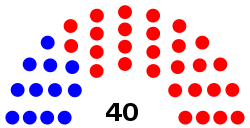Top Qs
Timeline
Chat
Perspective
Florida Senate
Upper house of the Florida Legislature From Wikipedia, the free encyclopedia
Remove ads
The Florida Senate is the upper house of the Florida Legislature, the state legislature of the U.S. state of Florida, the Florida House of Representatives being the lower house. Article III, Section 1 of the Constitution of Florida, adopted in 1968, defines the role of the Legislature and how it is to be constituted.[2] The Senate is composed of 40 members, each elected from a single-member district with a population of approximately 540,000 residents. The Senate Chamber is located in the State Capitol building.
The Republicans hold a supermajority in the chamber with 27 seats; Democrats are in the minority with 11 seats.[3] One seat is held by an independent, and one seat is vacant.
Remove ads
Terms
Article III of the Florida Constitution defines the terms for state legislators. The Constitution requires state senators from odd-numbered districts to be elected in the years that end in numbers that are multiples of four. Senators from even-numbered districts must be elected in even-numbered years, the numbers of which are not multiples of four.[4]
To reflect the results of the U.S. census and the redrawing of district boundaries, all seats are up for election in redistricting years, with some terms truncated as a result. Thus, senators in odd-numbered districts were elected to two-year terms in 2022 (following the 2020 census), and senators in even-numbered districts will be elected to two-year terms in 2032 (following the 2030 census).
Term limits
Candidates for re-election to the Florida Senate cannot appear on the ballot after serving for eight consecutive years. This was established by Amendment No. 9 (1992) affecting Article 6, Section 4 of the state Constitution.[4][5]
Remove ads
Qualifications
Florida legislators must be at least twenty-one years old, an elector and resident of their district, and must have resided in Florida for at least two years prior to election.[2]
Legislative session

Each year during which the Legislature meets constitutes a new legislative session.
Regular legislative session

The Florida Legislature meets in a 60-day regular legislative session each year. Regular sessions in odd-numbered years must begin on the first Tuesday after the first Monday in March. Under the State Constitution, the Legislature can begin even-numbered year regular sessions at a time of its choosing.[4]
Special session
Special legislative sessions may be called by the governor, by a joint proclamation of the Senate president and House speaker, or by a three-fifths vote of all legislators. During a special session, the Legislature may only address legislative business that is within the purpose or purposes stated in the proclamation calling the session.[4]
Powers and process
The Florida Statutes are the codified statutory laws of the state.[6]
Leadership
The Senate is headed by the Senate President, who controls the agenda along with the Speaker of the House and Governor.[citation needed]
- President: Ben Albritton (R)
- President Pro Tempore: Jason Brodeur (R)
- Majority Leader: Jim Boyd (R)
- Minority Leader: Lori Berman (D)
Remove ads
Composition
Remove ads
Members, 2024–2026
Summarize
Perspective
*Elected in a special election.
Remove ads
District map

Democratic Party
Republican Party
Past composition of the Senate
See also
Notes
- Democrat Geraldine Thompson (District 15) died.[7]
- Republican Randy Fine (District 19) resigned effective this date to run for Congress.[8]
- Jason Pizzo (District 37) changed party affiliation from Democrat to no party affiliation.[9]
- Republican Blaise Ingoglia (District 11) resigned after being appointed state Chief Financial Officer.[11]
- Republican Jay Collins (District 14) resigned after being appointed Lieutenant Governor.[12]
- Democrat LaVon Bracy Davis elected to replace Geraldine Thompson (District 15).[13]
- Republican Ralph Massullo elected to replace Blaise Ingoglia (District 11).[14]
Remove ads
References
External links
Wikiwand - on
Seamless Wikipedia browsing. On steroids.
Remove ads




